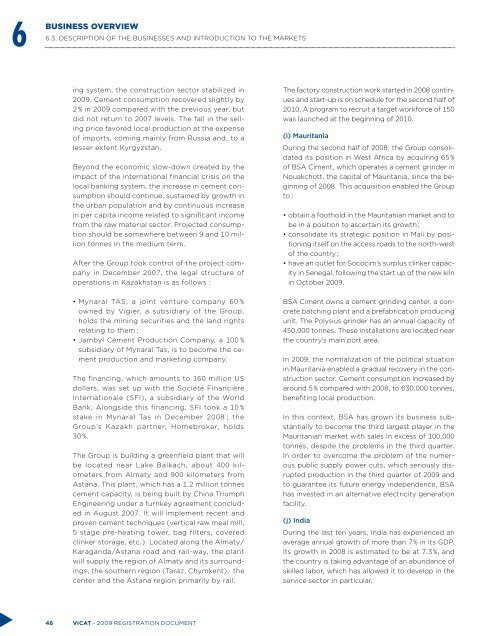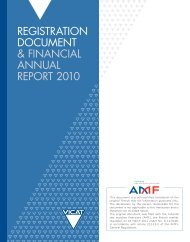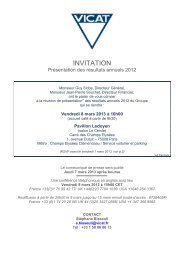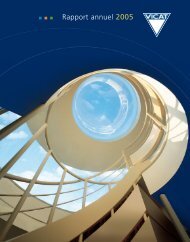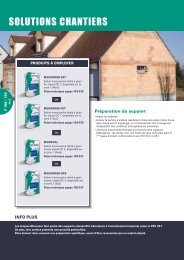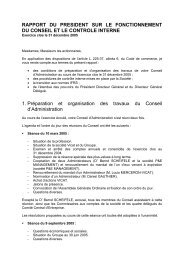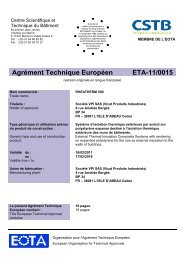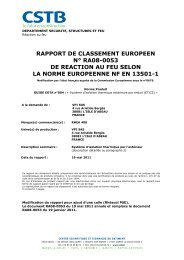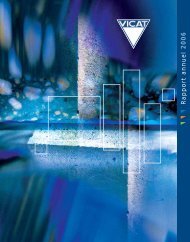6BUSINESS OVERVIEW6.3. DESCRIPTION OF THE BUSINESSES AND INTRODUCTION TO THE MARKETSing system, the construction sector stabilized in2009. Cement consumption recovered slightly by2 % in 2009 compared with the previous year, butdid not return to 2007 levels. The fall in the sellingprice favored local production at the expenseof imports, coming mainly from Russia and, to alesser extent Kyrgyzstan.Beyond the economic slow-down created by theimpact of the international financial crisis on thelocal banking system, the increase in cement consumptionshould continue, sustained by growth inthe urban population and by continuous increasein per capita income related to significant incomefrom the raw material sector. Projected consumptionshould be somewhere between 9 and 10 milliontonnes in the medium term.After the Group took control of the project companyin December 2007, the legal structure ofoperations in Kazakhstan is as follows :• Mynaral TAS, a joint venture company 60 %owned by Vigier, a subsidiary of the Group,holds the mining securities and the land rightsrelating to them ;• Jambyl Cement Production Company, a 100 %subsidiary of Mynaral Tas, is to become the cementproduction and marketing company.The financing, which amounts to 160 million USdollars, was set up with the Société FinancièreInternationale (SFI), a subsidiary of the WorldBank. Alongside this financing, SFI took a 10 %stake in Mynaral Tas in December 2008 ; theGroup’s Kazakh partner, Homebroker, holds30 %.The Group is building a greenfield plant that willbe located near Lake Balkach, about 400 kilometersfrom Almaty and 900 kilometers fromAstana. This plant, which has a 1.2 million tonnescement capacity, is being built by China TriumphEngineering under a turnkey agreement concludedin August 2007. It will implement recent andproven cement techniques (vertical raw meal mill,5 stage pre-heating tower, bag filters, coveredclinker storage, etc.). Located along the Almaty/Karaganda/Astana road and rail-way, the plantwill supply the region of Almaty and its surroundings,the southern region (Taraz, Chymkent), thecenter and the Astana region primarily by rail.The factory construction work started in 2008 continuesand start-up is on schedule for the second half of2010. A program to recruit a target workforce of 150was launched at the beginning of 2010.(i) MauritaniaDuring the second half of 2008, the Group consolidatedits position in West Africa by acquiring 65 %of BSA Ciment, which operates a cement grinder inNouakchott, the capital of Mauritania, since the beginningof 2008. This acquisition enabled the Groupto :• obtain a foothold in the Mauritanian market and tobe in a position to ascertain its growth ;• consolidate its strategic position in Mali by positioningitself on the access roads to the north-westof the country ;• have an outlet for Sococim’s surplus clinker capacityin Senegal, following the start up of the new kilnin October 2009.BSA Ciment owns a cement grinding center, a concretebatching plant and a prefabrication producingunit. The Polysius grinder has an annual capacity of450,000 tonnes. These installations are located nearthe country’s main port area.In 2009, the normalization of the political situationin Mauritania enabled a gradual recovery in the constructionsector. Cement consumption increased byaround 5 % compared with 2008, to 630,000 tonnes,benefiting local production.In this context, BSA has grown its business substantiallyto become the third largest player in theMauritanian market with sales in excess of 100,000tonnes, despite the problems in the third quarter.In order to overcome the problem of the numerouspublic supply power cuts, which seriously disruptedproduction in the third quarter of 2009 andto guarantee its future energy independence, BSAhas invested in an alternative electricity generationfacility.(j) IndiaDuring the last ten years, India has experienced anaverage annual growth of more than 7 % in its GDP.Its growth in 2008 is estimated to be at 7.3 %, andthe country is taking advantage of an abundance ofskilled labor, which has allowed it to develop in theservice sector in particular.46 VICAT - 2009 registration document
BUSINESS OVERVIEW6.3. DESCRIPTION OF THE BUSINESSES AND INTRODUCTION TO THE MARKETS6Since 2004, the Indian cement market has developedsteadily, with a growth of over 60 % in 5 years. The Indiancement market has thus seen continuous average annualgrowth of almost 10 % since 2004. Annual consumptionwas estimated at 198 million tonnes in 2009, whichmakes India the second largest market in the world forcement. However, cement consumption per capita hasremained weak, at approximately 155 kg per person.The population of India has reached 1.16 billion, 29 %of whom live in towns and cities, and India should becomethe most populous country on the planet byaround 2030. Although the global economic crisis isbeginning to affect Indian growth, growth in annualcement consumption should be maintained, fuelled bypopulation growth (estimated at 1.45 % in 2009) and itsswitch to nuclear power together with major plannedinfrastructure programs (roads, railways, dams, irrigation,ports and airports, etc.), should be maintained.On June 28, 2008, the Group announced the creationof a joint venture with the Indian cement manufacturerSagar Cements, established in the State of AndhraPradesh, which has been present in the Indian marketfor 25 years and has a capacity of 2.5 million tonneswith its new line which came on stream in July 2008.The objective of <strong>Vicat</strong> Sagar Cement is to build agreenfield cement factory in the south of India, 700kilometers from Mumbai and 170 kilometers fromHyderabad. The new plant will be located in theGulbarga cluster in the State of Karnataka. The plantwill ultimately have a cement production capacityof 5.5 million tonnes, with two clinker lines producing6,000 tonnes per day. Construction of the firstof the two production lines will begin in 2010 withstart up scheduled for 2012 (see also Sections 5.2.2.“Principal investments in progress and planned” and12.2.3. “Industrial investments”).The new plant will implement recent and proven cementmill techniques (raw meal roller mill, 6 stage preheatingtower, bag filters, covered clinker storage,etc.) and will have its own power generation plant. Itwill be connected to the railway network and be ableto supply the States of Karnataka, Maharashtra andAndhra Pradesh and the main metropolitan centresof Mumbai, Pune, Bangalore and Hyderabad.6.3.2. Ready-mixed concrete and AggregatesThe Ready-mixed concrete and Aggregates businessesaccounted for 36.7 % of Group sales, that isalmost 696 million euros of consolidated sales in2009 (845 million euros in 2008 and 914 million eurosin 2007), and 17.5 % of the Group’s EBITDA for thissame period (20.7 % in 2008 and 24.7 % in 2007).The Ready-mixed concrete and Aggregates businessesare managed within the same segment, becauseof the similarity of their customers and theGroup’s vertical integration policy.Concrete and aggregates constitute, just as cement,the essential components of construction projectsthroughout the world. The Ready-mixed concreteand Aggregates businesses were integrated in eachof these countries by the acquisition and creationof many companies. At the end of 2009, the Groupoperated 75 aggregates quarries and 241 concretebatching plants, distributed over five countries, andhad sold 18.7 million tonnes of aggregates and 7.1million m 3 of concrete.The Group initially developed its activity in Readymixedconcrete and Aggregates in France throughinvestments during the 1980s. The Group then pursuedits goal of vertical integration by selective acquisitions,firstly in the market areas of its Cementbusiness, and secondly by the development of itsindustrial equipment in its existing locations.6.3.2.1. Products(a) Ready-mixed concreteConcrete is a mixture of cement, aggregates, additivesand water, which hardens to form a constructionmaterial whose principal qualities are its strengthunder tension and under pressure, durability, quicksetting times, ease of pouring and ease of handlingunder various climatic and construction conditions.The qualities and performance of a concrete can beobtained and guaranteed only if the physico-chemicalformulation of the concrete and its productioncycle are rigorously respected. In order for concreteto be formulated perfectly, the various componentsmust be precisely proportioned in a given order andat a given rate. Mixing must then be continuous andhomogeneous. These production constraints explainwhy concrete manufactured in a batching plant is of asuperior quality and uniformity to any concrete mixedmanually or in a concrete mixer. It is the fundamentalreason for the growth of ready-mixed concrete,which guarantees compliance with the standards laiddown in construction work specifications.2009 registration document - VICAT 47


